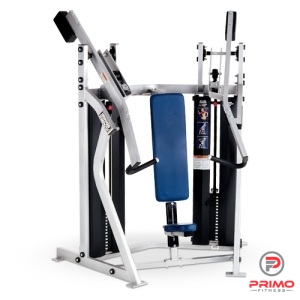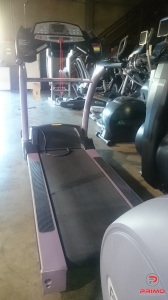Stair Climbing is one of the most popular and effective workouts out there. It works the entirety of the legs, along with abs and more. In the past, people have climbed stairs using real stairs or steps. You may remember the moment in the film “Rocky” where the main character ran up the steps of the Philadelphia Museum of Modern Art as the final part of the training montage!
However, stair climbing doesn’t need real stairs or even much space. Rather than relying on the stairs near your home, you can get the same benefits (and maybe even more) from a StairMaster.
These stair climbing machines have been around since the ‘80s. However, the technology has improved over the last four decades to include features like a heart rate monitor and calorie counter to provide you with data that impacts your overall health and wellness.
What is a StairMaster?
A StairMaster is a stationary fitness machine, generically known as a stair climber, that mimics the effects of climbing up a set of stairs. It’s similar to a treadmill in that it allows the user to climb at a preset speed or duration. However, it uses steps as a workout instead of walking or running. StairMasters are known to provide users with an intense cardio workout to target lower body muscles, including:
- quadriceps
- hamstrings
- calves
- glutes
Cardio Benefits of StairMaster
A StairMaster can provide the user with benefits from strength training to cardio. If you normally walk or run, stair climbing can help you get a different type of cardio exercise that’s completely transformative.
Aerobic Conditioning
Stair climbing is a great aerobic exercise because it strengthens both the heart and lungs. Stronger lungs help you breathe in more necessary oxygen, while a healthy heart pumps oxygen-rich blood into your muscles and organs.
Burning Calories
The main reason many people use a StairMaster is to lose or manage weight. A StairMaster exercise can burn hundreds of calories in the short span of half an hour. Of course, how effective this will be depends on your body weight and the intensity of the workout. Still, simply going at a slow and steady pace can help you burn more calories than walking alone.
A fast climb will burn more calories than a slow one. However, it’s important that you go at your own pace and don’t overdo it so that you can sustain the workout and burn more calories in the long run.
StairMasters now come with a calorie calculator, which will estimate the number of calories you’re burning with each step based on your weight. After entering specific information about your weight and other parameters, these calorie-burning calculators are fairly accurate.
Strength Benefits of StairMaster
StairMasters also provide you with the benefits of strength. They can build muscle and tone the body.
Core Strength
Using a StairMaster requires your body to maintain your balance throughout the workout while you’re using your largest muscle group: your legs. Because of this, it can gently but effectively workout your entire core. A stronger core means a more improved posture and reduces lower back pain and the risk of injury.
Bone Health
Exercises that are weight-bearing, like climbing stairs, can improve bone health. This means reducing the risk of bone conditions like osteoporosis. If you already have osteoporosis, climbing stairs can help treat it. Because bones are considered living tissue, a Stairmaster can increase bone mass, which means stronger bones.
Strengthening your bones is important no matter what age you are, but especially as you get older. Bone density loss is something you need to worry about as you age, so it’s important to hop on the StairMaster now and continue to strengthen your bones.
Quadriceps Strengthening
The quads are a muscle group in the front of the thigh. These muscles are essential for daily activities like walking, running, and standing up from sitting on the couch. These muscles help extend or straighten the knee. Therefore, each time you take a step on the StairMaster, you are strengthening these muscles.
Hamstring Strengthening
Your hamstrings are muscles located in the back of your thigh. They work with the quads to help you move your lower body. They also help bend the knee, so they are critical for walking, running, and sitting.
Each time you take a step, you are bending your knee. In this case, the hamstrings are doing most of the work and becoming stronger.
Calves Strengthening
Your calves also help you run, walk, and jump. They’re also critical for maintaining your balance while you’re standing. Each time you take a step, your calves will contract. Your calves are responsible for helping you lift your heel when you walk or run, so keeping them strong is important, especially as you age.
Glute Strengthening
Many people use StairMasters to target their glutes. The glutes are the muscles located in your buttocks. Believe it or not, they’re actually some of the strongest muscles in our bodies.
The glutes primarily move the hips and thighs. Therefore, climbing stairs relies heavily on these muscles.
Other Benefits of Using a StairMaster
Relief from Knee Pain
Each time you take a step, you are effectively strengthening your knee. This will reduce stress on the joints, which can help reduce pain, especially if you have osteoarthritis. StairMasters are considered low-impact because you’re not pounding the hard pavement and causing a vibration through your leg tissues.
Because of this, climbing a StairMater is ideal for those with knee or joint pain.
Better Mood
Climbing stairs, like every other exercise, releases endorphins. These are known as the happy chemicals in your brain that boost mood. Endorphins also reduce stress levels. Even though you may feel a little tired after a workout, you should feel more positive and awake than you did before getting on the machine.
A StairMaster can provide you with an effective cardio workout while strengthening the main muscle groups in your lower body, and abs! Because you’re doing essentially two different types of exercises at the same time, you won’t have to spend too much time to see and feel the results.
When using a StairMaster for the first time, it’s important to start slow and work your way up to more intense and longer exercises.




